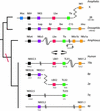Dispersal of NK homeobox gene clusters in amphioxus and humans
- PMID: 12704239
- PMCID: PMC154338
- DOI: 10.1073/pnas.0836141100
Dispersal of NK homeobox gene clusters in amphioxus and humans
Abstract
The Drosophila melanogaster genome has six physically clustered NK-related homeobox genes in just 180 kb. Here we show that the NK homeobox gene cluster was an ancient feature of bilaterian animal genomes, but has been secondarily split in chordate ancestry. The NK homeobox gene clusters of amphioxus and vertebrates are each split and dispersed at two equivalent intergenic positions. From the ancestral NK gene cluster, only the Tlx-Lbx and NK3-NK4 linkages have been retained in chordates. This evolutionary pattern is in marked contrast to the Hox and ParaHox gene clusters, which are compact in amphioxus and vertebrates, but have been disrupted in Drosophila.
Figures




Similar articles
-
The amphioxus Hox cluster: deuterostome posterior flexibility and Hox14.Evol Dev. 2000 Sep-Oct;2(5):284-93. doi: 10.1046/j.1525-142x.2000.00070.x. Evol Dev. 2000. PMID: 11252557
-
The ParaHox gene cluster is an evolutionary sister of the Hox gene cluster.Nature. 1998 Apr 30;392(6679):920-2. doi: 10.1038/31933. Nature. 1998. PMID: 9582071
-
Evidence for 14 homeobox gene clusters in human genome ancestry.Curr Biol. 2000 Sep 7;10(17):1059-62. doi: 10.1016/s0960-9822(00)00676-x. Curr Biol. 2000. PMID: 10996074
-
Beyond the Hox: how widespread is homeobox gene clustering?J Anat. 2001 Jul-Aug;199(Pt 1-2):13-23. doi: 10.1046/j.1469-7580.2001.19910013.x. J Anat. 2001. PMID: 11523814 Free PMC article. Review.
-
[Hox genes, developmental evolution and the origin of vertebrates].Ontogenez. 1996 Jul-Aug;27(4):273-9. Ontogenez. 1996. PMID: 8975203 Review. Russian.
Cited by
-
The genetic factors of bilaterian evolution.Elife. 2020 Jul 16;9:e45530. doi: 10.7554/eLife.45530. Elife. 2020. PMID: 32672535 Free PMC article.
-
Patterns of conservation and change in honey bee developmental genes.Genome Res. 2006 Nov;16(11):1376-84. doi: 10.1101/gr.5108606. Epub 2006 Oct 25. Genome Res. 2006. PMID: 17065607 Free PMC article.
-
Comprehensive survey and classification of homeobox genes in the genome of amphioxus, Branchiostoma floridae.Dev Genes Evol. 2008 Dec;218(11-12):579-90. doi: 10.1007/s00427-008-0245-9. Epub 2008 Sep 17. Dev Genes Evol. 2008. PMID: 18797923
-
Diversity, duplication, and genomic organization of homeobox genes in Lepidoptera.Genome Res. 2023 Jan;33(1):32-44. doi: 10.1101/gr.277118.122. Epub 2022 Dec 8. Genome Res. 2023. PMID: 36617663 Free PMC article.
-
Ancestral whole-genome duplication in the marine chelicerate horseshoe crabs.Heredity (Edinb). 2016 Feb;116(2):190-9. doi: 10.1038/hdy.2015.89. Epub 2015 Sep 30. Heredity (Edinb). 2016. PMID: 26419336 Free PMC article.
References
-
- Jagla K, Jagla T, Heitzler P, Dretzen G, Bellard F, Bellard T. Development (Cambridge, UK) 1997;124:91–100. - PubMed
-
- Jagla K, Bellard M, Frasch M. BioEssays. 2001;23:125–133. - PubMed
-
- Galliot B, de Vargas C, Miller D. Dev Genes Evol. 1999;209:186–197. - PubMed
-
- Pollard S L, Holland P W H. Curr Biol. 2000;10:1059–1062. - PubMed
-
- Harvey R P. Dev Biol. 1996;178:203–216. - PubMed
Publication types
MeSH terms
Associated data
- Actions
- Actions
- Actions
- Actions
- Actions
- Actions
- Actions
- Actions
LinkOut - more resources
Full Text Sources
Research Materials

